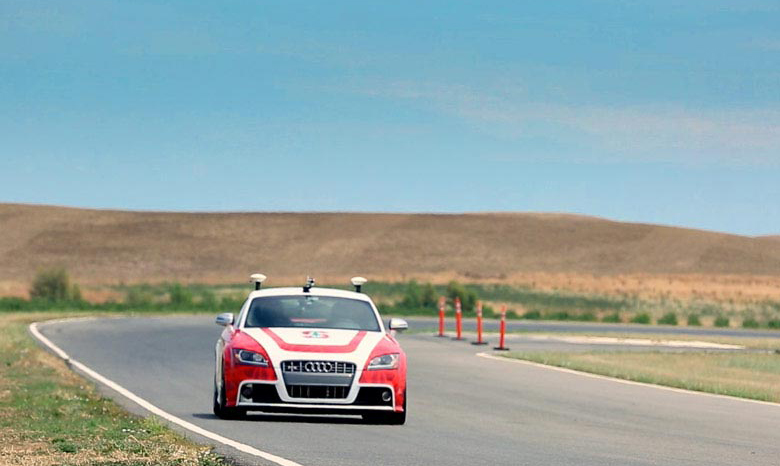Stanford’s autonomous car hits speeds of 120 mph
University project seeks to create safer automatic braking systems

Google and other driverless car makers are in a race to get their machines certified for road use, but a project at Stanford University has already put an autonomous car on a racetrack at high speed in a bid to create safer automatic braking systems.
Professor Christian Gerdes and his mechanical engineering students have been testing their autonomous driving algorithms with Shelley, a custom-rigged Audi TTS, on the three-mile track at Thunderhill Raceway in Willows, California.
The car is capable of hitting speeds of 120 mph, though has predominantly been manoeuvring between 50 to 75 mph. Following iterations on the software, the car is nearly as quick around the track as an expert racer.
These speeds are closest to which most car collisions occur, according to Gerdes. He and his students want to understand how the autonomous car adjusts its throttle, brakes and makes use of all the friction of its tires in different situations to inform the development of automatic collision avoidance software.
"A race car driver can use all of a car's functionality to drive fast," said Gerdes. "We want to access that same functionality to make driving safer."
Gerdes is a professor of mechanical engineering at Stanford, a university with a storied history of producing graduates who have gone on to create world-changing inventions in technology, politics and the arts.
Several graduates from Gerdes' lab have landed careers in the automotive industry. The professor prioritises student-inspired research on track days and grants his students autonomy to manage their research.
Get the ITPro daily newsletter
Sign up today and you will receive a free copy of our Future Focus 2025 report - the leading guidance on AI, cybersecurity and other IT challenges as per 700+ senior executives
"The students organise themselves like a race team for our test days. They figure out tasks and schedule the time allotted for different tests together," Gerdes said. "But once you get to the track, things can go differently than you expect. So it's an excellent lesson of advanced planning, but also how to come together as a team and deal with changing priorities."
Stanford's effort is the latest in a number of autonomous car projects from private industry and government-backed. The US government's Department of Transport told Google that its autonomous driving system could be considered as the driver' last month, bringing the cars another step closers to hitting public streets.
Photo: Stanford/Bjorn Carey/Kurt Hickman/Aaron Kehoe
-
 Cleo attack victim list grows as Hertz confirms customer data stolen
Cleo attack victim list grows as Hertz confirms customer data stolenNews Hertz has confirmed it suffered a data breach as a result of the Cleo zero-day vulnerability in late 2024, with the car rental giant warning that customer data was stolen.
By Ross Kelly
-
 Lateral moves in tech: Why leaders should support employee mobility
Lateral moves in tech: Why leaders should support employee mobilityIn-depth Encouraging staff to switch roles can have long-term benefits for skills in the tech sector
By Keri Allan